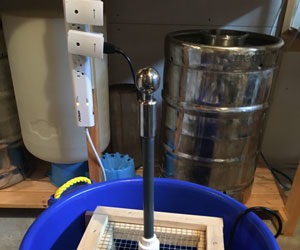Build a Flight Serving Tray
A variety of homebrewed beers on tap is a great way to impress your family and friends. But, when your guests have to drive home afterwards, they likely aren’t going to be up for a pint of each selection. Enter the flight serving tray (or paddle). Conveniently holding sample size glasses, flight trays should be a part of every homebrewery that has a selection of brews to offer. Here, four homebrewers offer their own designs that you can use to build a flight tray of your own.
Raised Paddle Style

To drill the holes, I used a 21⁄2-Forstner bit. After cutting the wood to length, I marked the piece of wood that will be the paddle, leaving 11⁄2 inches (3.8 cm) from one end to the edge of the first hole, and leaving 1 inch (2.5 cm) between each hole. With the remaining 41⁄2 inches (11 cm) I designed a handle that is 11⁄2 inches (3.8 cm) wide. The handle can be cut with a band saw or jig saw. On the legs I marked in the middle of the piece, 1⁄2 inch (1.25 cm) from the bottom and using a 1⁄2-inch drill bit, I drilled 1⁄2 inch deep for the dowel to fit into. This dowel acts as a base to rest your sample glass on.
Next I glued the pieces together using a pin nailer to hold it together while the glue sets.
I rounded some edges on a belt sander and also used a router on the top edge to add some more detail. Optionally, you can sand by hand. Then finish it off with one final sand, stain and polyure-thane, and get some flight glasses to put it to use. – Tom Hoefkes
Parts & Tools
3⁄4-inch (2-cm) Poplar wood (26 x 4 1⁄2 inches/66 x 11.5)
1⁄2-inch (1.25 cm) diameter wood dowel (14 inches/36 cm)
Glue Polyurethane
21⁄2-inch Forstner bit
1⁄2-inch drill bit
Jig saw/band saw
Drill
Nail gun
Sander/sanding block
Router (optional)
Tray Style

Drilling: Place a scrap piece of wood under the piece of wood you intend to drill. This will prevent the back of your board from tearing out. It will work best if you can use a clamp to secure the pieces of wood. Using a 2-inch Forstner bit, drill the holes at the intersections you marked earlier at a slow and steady pace without exerting too much pressure.
Routing: The best way to create the handles is to use a router with a router guide. The template for the router guide can be fabricated out of a piece of metal or particle board and designed according to your aesthetic. Position the template where you would like the beer flight handles to be located and clamp it down. Use the router to create the cavities for your handle.
Sanding: Use of an electric sander will be most efficient for this project, but the wood pieces can also be hand sanded. Begin by using 80 grit sandpaper, then move up to 120, then 180, and finish at 220. Sand every surface including the grain, edges, and holes. The more time spent on sanding will provide a better finish. Staining Select an oil- or water-based wood stain. Before beginning the staining process, clean the wood thoroughly with a clean rag. Next, mix your wood stain according to manufacturer specifications. Spread the stain evenly to ensure proper coating. More coats can be applied to achieve a darker end product. If applying several coats allow each coat to dry completely before applying the next.
Finishing: An optional last step is to apply a Poly-Clear finish once you are done staining. This will seal and protect your beer flight for years to come. – Nathan Siswanto
Parts & Tools
1×4 lumber (14 inches/35 cm long)
Wood stain
Poly-Clear
Template for handles (I designed one at www.instructables .com/id/How-to-make-a-router-guide-for-perfect-cuts/)
Drill or drill press
2-inch Forstner drill bits or hole saw
Router with router guide (1⁄4 or 1⁄2 drive)
Sandpaper
Clamps
Paddle Style

Design: Start by drawing your paddle to scale on a piece of paper. I used 1 cm for 1 inch. That way, I can measure my drawing and multiply the dimension by 2.54 to get the real measurement. You can also just space out the glasses on the wood and leave some room for the handle. On my paddle, I allocated around 6 inches (15 cm) to the handle, which left 12 inches (30 cm) for the glasses.
Woodworking: After marking the wood with a pencil, pre-drill the center using a 1⁄8-inch bit, about 1⁄2-inch (1.27 cm) deep. This will keep the Forstner bit centered. Using a 21⁄4-inch Forstner bit, use the four small holes as the center and go down a 1⁄2-inch (1.25 cm). You will end up with four nice circular cavities with a tiny hole in the middle. If you want to get rid of the center hole, you will need to use a router or a CNC to remove a layer of wood at the bottom of the cavities. You could also just put a round piece of cork to cover it. Cutting the handle can be done with a handsaw, a scroll saw, a jig saw, a band saw, etc. I used a bandsaw available at the local makerspace. Using a guide will help you make straight cuts fast. Once you’ve cut both sides of the handle, flip the paddle on its side and cut out ~1⁄2-inch (1.25 cm) from the bottom of the handle. This will create some room for your fingers when you later grab the paddle from the table.
Finishing: To smooth out the paddle you can use a bastard file to quickly shape a radius and then use coarse sandpaper to remove the file marks. Once the desired curve is reached, finish with fine sandpaper (220) until all scratches are gone. The last thing to do is to apply coating. I used polyurethane varnish mixed with paint thinner as a first coat to get the varnish to penetrate the wood in depth. Let dry, sand lightly, and apply a second coat. If you want to get fancy, an option would be to paint one side of the paddle with chalkboard paint and use it to write down the name of the beers. –Thomas Jacquin
Parts & Tools
2×4 piece of hardwood (18 inches/46 cm long) per paddle.
(4) 5 oz. glasses
Varnish
21⁄4-inch Forstner bit
Saw (a band saw works great if you have access to one)
Bastard file
Coarse and fine sand paper (100 & 220 is a good choice).
* If you have access to a CNC machine then you won’t need the Forstner bit.
Skeleton Key Style
 I came up with this unique design for a tasting paddle after visiting my local brewery (Proclamation Ale Co. in West Kingston, Rhode Island). With each tasting, you took home a 5 oz. snifter glass. All beer flight paddles I have seen usually incorporate simple glassware. I felt that a flight paddle that accommodated style appropriate glasses was in order. I used the 5 oz. snifter glasses from Proclamation Ale but you can purchase similar size snifter glasses from numerous retailers online. The paddle can also be scaled to accompany any size snifter or tulip-style glass. I hope you enjoy this one-of-a-kind paddle as much as I do!
I came up with this unique design for a tasting paddle after visiting my local brewery (Proclamation Ale Co. in West Kingston, Rhode Island). With each tasting, you took home a 5 oz. snifter glass. All beer flight paddles I have seen usually incorporate simple glassware. I felt that a flight paddle that accommodated style appropriate glasses was in order. I used the 5 oz. snifter glasses from Proclamation Ale but you can purchase similar size snifter glasses from numerous retailers online. The paddle can also be scaled to accompany any size snifter or tulip-style glass. I hope you enjoy this one-of-a-kind paddle as much as I do!
Measuring: Cut a 3⁄4-inch (2-cm) thick piece of wood approximately 20 x 4 inches (50 x 10 cm). Before drilling or cutting, use a pencil to sketch all holes and double check measurements.
Drill divots to rest glasses on: Starting 2 inches (5 cm) from one end of the plank, use the 13⁄4-inch Forstner bit to drill down 1⁄4 inch deep into the wood. This divot ensures that the tasting glasses sit firmly in place and will not slide out easily. Repeat this step three times to form four divots in a straight line in the center of the plank. Each hole should be 31⁄4 inches (8.3 cm) apart (measured from the center of the divot), allowing enough room for the four tasting glasses to fit without touching.
Drill holes for glass stems: Drill a hole all the way through each divot with the 3⁄4-inch spade bit. Cut out glass stem paths With the holes and divot made in the plank of wood, it is now time to cut out the wood so the glasses can be slid into place. Using a bandsaw (or carefully with a jigsaw), cut out a 3⁄4-inch strip from the edge of the plank into the pre-drilled holes. Do this for each of the four holes.
Cut handle: Now it is time to design and cut out your handle. The handle can be any shape you want. I opted for the simple straight and narrow design, which makes the paddle easy to hold
Finishing :All that is left is the finishing touches. Sand down all of the edges and then finish the paddle with your choice of coating/paint and enjoy! – Alex MacIntosh
Parts & Tools
(4) 5 oz. stemmed tasting glasses such as snifter/tulip/ goblet styles (I got mine from a local brewery in Rhode Island, but they can be found online)
1 x 4 piece of wood (20 inches/50 cm long)
Drill press
13⁄4-inch Forstner bit
3⁄4-inch spade bit
Band saw
Sandpaper
Polyurethane/paint (optional)



